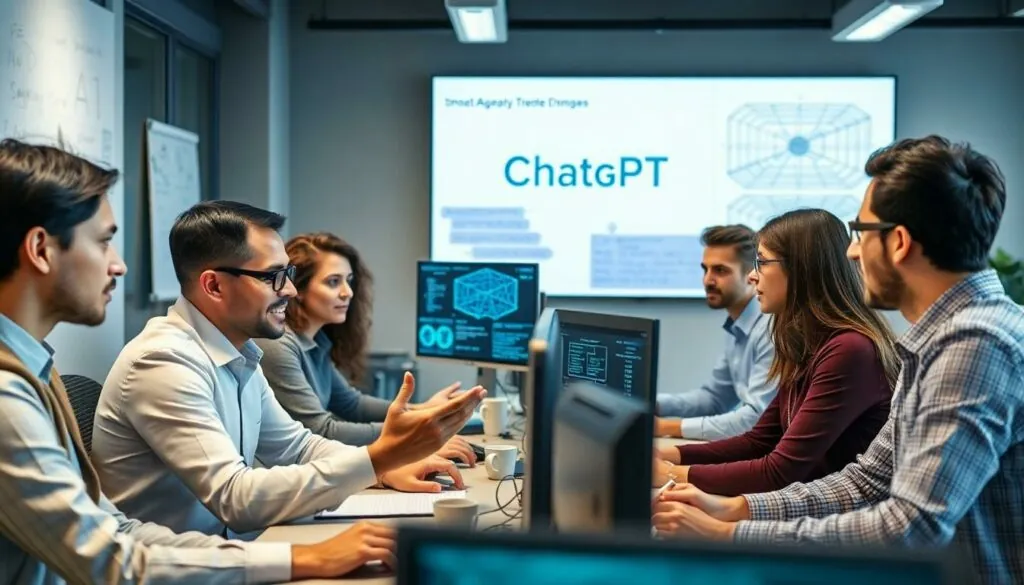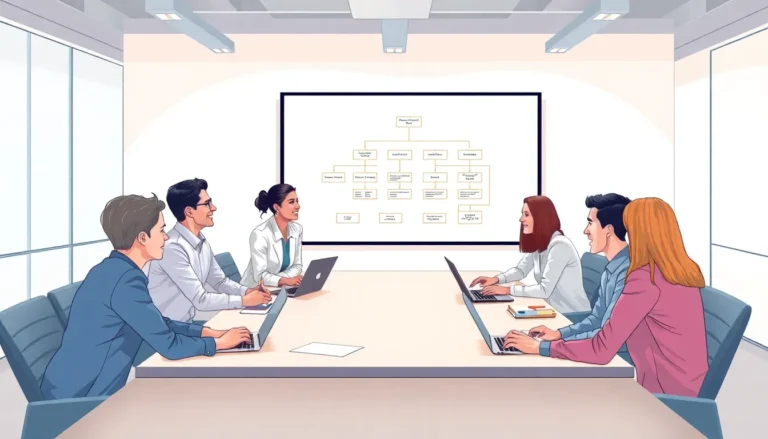Table of Contents
ToggleIn a world where technology evolves faster than a cat meme goes viral, the development of ChatGPT stands out as a fascinating tale of innovation. Imagine a team of brilliant minds, fueled by coffee and sheer determination, working tirelessly to create a conversational AI that can chat like your best friend but with a little more data and a lot less drama.
But just how long did it take to bring this digital marvel to life? Spoiler alert: it wasn’t just a weekend hackathon. From brainstorming sessions to countless iterations, the journey to ChatGPT’s launch was a rollercoaster of creativity and code. Buckle up as we dive into the timeline of this groundbreaking project, revealing the twists and turns that led to one of the most talked-about AI systems in recent history.
Overview of ChatGPT Development
ChatGPT’s development spans several years, showcasing a blend of expertise and technological advancements. In 2018, OpenAI introduced the first version of the Generative Pre-trained Transformer (GPT), which laid the groundwork for subsequent models. The groundwork for ChatGPT began with extensive research and testing, involving significant computational resources and innovative algorithms.
Many iterations occurred before reaching the final product, with each version refining previous capabilities. Development relied on vast datasets, allowing the model to learn from a diverse range of human conversations and text. Research teams focused on improving the model’s ability to generate coherent responses while minimizing biases and maintaining user safety.
OpenAI publicly released ChatGPT in November 2022. Response times and user interactions revealed areas for improvement, prompting ongoing refinements. As feedback from users flowed in, it further guided enhancements to functionality and user experience. Continuous updates followed, with the team aiming to address limitations and optimize performance.
In total, the process took multiple years, involving not just the creation phase but also extensive testing and iteration. The assembled team’s dedication fostered innovation while prioritizing transparency and user feedback. Each step in the development cycle emphasized the importance of building an AI that could engage in natural, friendly dialogue without emotional complexities.
During the development journey, challenges included ensuring the model understood context and avoiding misinterpretation. Collaboration among various experts, including researchers and engineers, proved crucial in overcoming these hurdles. With a foundation built on cutting-edge research, ChatGPT emerged as a notable achievement in conversational AI.
Timeline of Major Milestones

The development of ChatGPT unfolded over several key phases, showcasing significant advancements in AI technology.
Initial Research and Development
OpenAI launched its first Generative Pre-trained Transformer (GPT) in 2018. This initial version set the stage for subsequent iterations by introducing innovative techniques in natural language processing. In the following years, extensive research focused on improving model architecture and refining training methodologies. Data from diverse sources became critical in teaching the model to generate coherent responses. Prioritizing user safety, the team worked diligently to minimize biases and ensure reliable outputs. Ongoing evaluations identified areas for improvement, helping shape the model’s evolution. Collaboration among researchers, engineers, and domain experts played a vital role during this formative stage.
Key Releases and Updates
The journey of ChatGPT featured several pivotal releases after its initial research phase. OpenAI announced GPT-2 in February 2019, which prompted discussions about AI’s capabilities and ethical considerations. Building on this, GPT-3 followed in June 2020, marking a leap in performance and complexity. By November 2022, OpenAI publicly launched ChatGPT, soliciting user feedback to drive enhancements. Continuous updates post-launch focused on refining conversation quality and understanding context. Each iteration revealed significant improvements in response accuracy and ability to engage users naturally. These releases demonstrated OpenAI’s commitment to transparency and user-centered development throughout the evolution of ChatGPT.
Factors Influencing Development Duration
Several factors influenced the timeline of ChatGPT’s development. These elements range from technology advancements to team expertise.
Technology Advancements
Innovations in artificial intelligence directly impacted the speed of development. The evolution of natural language processing techniques enabled more sophisticated model architectures. Integrating large datasets allowed for improved training processes, resulting in refined outputs. In particular, the transition from GPT to GPT-2 and GPT-3 showcased rapid advancements in AI capabilities. Enhanced computational resources also played a crucial role, accelerating research and testing phases. Each breakthrough contributed to overall efficiency, minimizing the time between iterations.
Team Expertise and Collaboration
The skills and collaboration of the team significantly affected the development duration. Researchers, engineers, and scientists united their expertise to tackle complex challenges. A diverse range of backgrounds fostered creativity and innovative problem-solving. Frequent brainstorming sessions helped identify critical areas for improvement, streamlining the development process. Feedback from user interactions further informed adjustments, ensuring responsiveness to real-world applications. The commitment to open dialogue and teamwork allowed for a more agile approach, ultimately enhancing the final product.
Impact of Development Time on ChatGPT’s Performance
Development time significantly influenced ChatGPT’s overall performance. The extensive timeline allowed for thorough research, leading to well-refined models. Iterative advancements, stemming from initial 2018 efforts, helped the team address various challenges encountered during the process.
Each phase contributed to enhancing functionality. For instance, the release of GPT-2 in February 2019 and GPT-3 in June 2020 showcased escalating capabilities in natural language understanding. As development progressed, the incorporation of large datasets improved the content quality and coherence of responses.
User feedback played a pivotal role in shaping subsequent versions. Following the public launch in November 2022, adjustments were made to respond better to user interactions. Fine-tuning continued to enhance the AI’s capacity to engage in natural conversations.
Collaborative efforts among researchers, engineers, and scientists reinforced the development process. This teamwork promoted innovative solutions, which directly affected the AI’s adaptability and performance. Various technological advancements also streamlined training protocols, enabling more efficient model iterations.
Finally, understanding and addressing ethical considerations became integral as the project evolved. Each update aimed to minimize biases and prioritize user safety, ensuring that ChatGPT engages users in a trustworthy manner. The strategic balance between development time, technological resources, and user insights established a strong foundation for ChatGPT’s capabilities.
The journey of developing ChatGPT reflects a significant achievement in artificial intelligence. It showcases the dedication of the OpenAI team and their commitment to creating a conversational AI that meets user needs. The extensive timeline highlights the importance of thorough research and iterative improvements.
With each version, the team focused on enhancing capabilities while addressing ethical considerations and user safety. The collaborative efforts and continuous feedback loops have been crucial in shaping ChatGPT into a reliable tool. As technology continues to evolve, the foundation laid during ChatGPT’s development will undoubtedly influence future advancements in AI.







